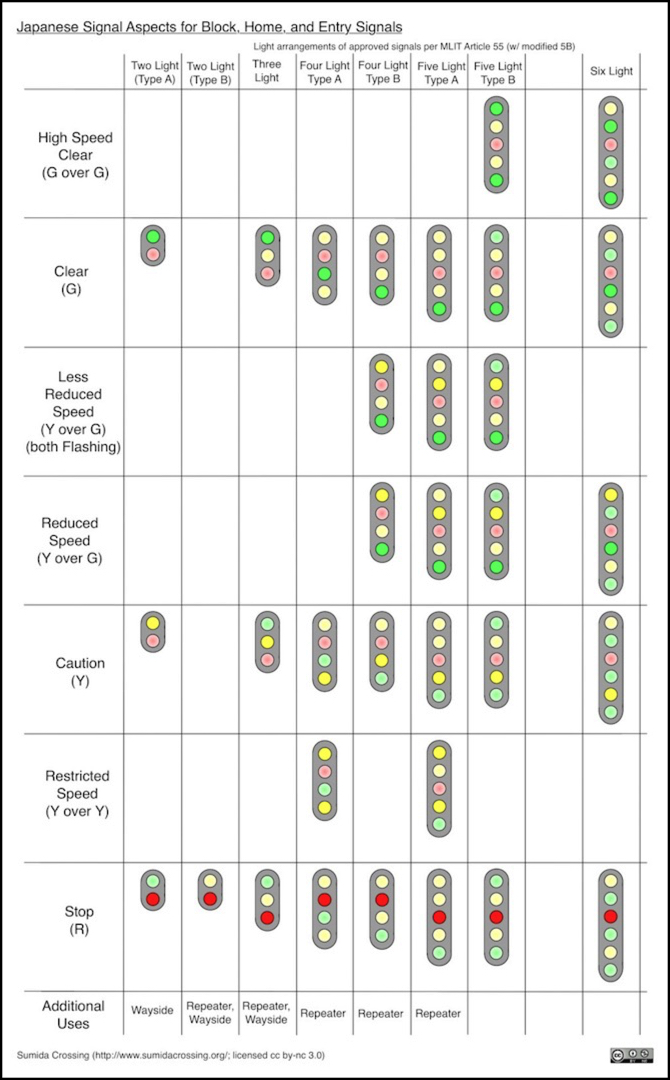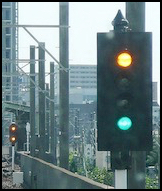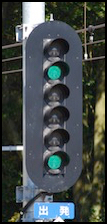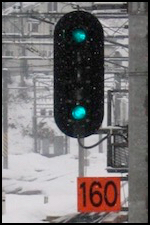Japanese Signal Aspects
Per Japanese regulations, there are seven possible signal indications, with multiple aspects used for each, as can be seen in the diagram below. Not all of these will be used on the same line, and many lines use only three-aspect or four-aspect signals at most, and even on those lines signals with fewer aspects will be used in some places. In some cases two lights of the same color may be lit, when such an aspect is used, the lights must be separated by at least two dark lamps (three for High Speed Clear), so the two are easy to distinguish from a single light at a distance. This restriction places some limits on which aspects can be displayed by which signal heads.
All references to “the MLIT document” are to an English translation of Japanese regulations and standards applying to signals (c. 2006). See Technical Standard for Japanese Railway in the references section at the end of the Japanese Signaling page. This page has been updated in early 2016 after re-reading this document.
Additional example images can be found on the Reference Images Example Signals page.

As described below, the five-light type B has some conflicting information regarding it, and may not be correct (or may not be the only possible alternate).
Notes:
- Signals in the above diagram are generally per the MLIT document, which shows signal light color and arrangement as per “Approved Model Specifications, Article 55” for Home, Block and Starting signals.
- Some of the signals also appear in the sections on Wayside and Repeater signals as noted on the diagram.
- Article 55 doesn’t state which lamps are lit when there is more than one option, except to note that there must be “at least one” dark lamp between lit ones. However, on further reading there is a specification on the spacing between lamps (see below) that requires leaving two unlit lamps between signals for aspects Less Reduced Speed, Reduced Speed and Restricted Speed, and three unlit lamps for High Speed Clear.
- Further, Article 55 lists the valid aspects for each type of head, and those combinations all allow for two unlit lamps between lit ones (3 on High Speed Clear), so I have used that in the above.
- The four-lamp type B head is commonly used on JR lines near Tōkyō as a block signal (and in at least one instance inside a station as a home/starting signal to divide it into two parts).
- There does not appear to be any reason why the six-lamp signal could not be used to give every possible indication, however the MLIT document clearly omits two of them from its list.
Signal Lamp Size and Spacing
Lamps on normal color-lamp signals are required to be at least 100mm in diameter and spaced at least 200mm apart (center to center) (per the MLIT document, Approved Model Specifications, VII-2 Art. 55 (1)(1)). See the Signal Types page for additional details. When two lights on the same head are lit, they must be at least 600mm apart (center to center) but not more than 700mm, which means that exactly two dark lights must be between them (Art. 55 (1)(11)). The exception is two lamps used for a High Speed Clear aspect, which must be 800mm to 900mm apart, meaning exactly three dark lamps must be placed between them.
In tunnels these spacings are allowed to be slightly reduced. Lit color-lamp signals may be 540mm apart rather than 600mm (there’s no spacing defined for high-speed clear signals in a tunnel).
Five Lamp Signals
This is an area where there is some confusion (at least for me) over what is allowed/required and what is actually used. The MLIT document (in Approved Model Specifications, VII-2 Art. 55 (1)(1)) clearly shows two forms, the YYRYG identified as 5A in Japanese Wikipedia, and a GGYRG form. Japanese Wikipedia however omits the second form and has a 5B with a GYRYG arrangement.
Japanese wikipedia doesn’t seem to have an example of this use of the second lamp though. They do include a photo of a signal (c. 2007) showing High Speed Clear (green over green) on a five-lamp signal, described as being on the Hokuetsu Express Line (that’s the company name, the actual line name in English is Hokuhoku, and the train was the Hakutaka express service before that name was reused for the replacement Shinkansen in 2015). However, this could easily be either form, since the color of the second lamp can’t be seen.
The difference is that the “approved” version lacks the lamp spacing needed to allow Less Reduced Speed or Reduced Speed (there’s only one lamp between yellow and the lower green, and two are required as noted above).
Either Wikipedia is wrong, or the document I’m citing (which is a translation of a summary of the original) contains a typo, or this is a “5C” form added after High Speed Clear was introduced. I’m going to assume the translation is wrong as it seems unlikely that an error in Wikipedia would have persisted for several years without correction. And, the form shown in Wikipedia allows more flexibility (the two missing aspects) and there’s no purpose for the second lamp if it is green. However, it is still possible that Japanese Wikipedia is incorrect here, unlikely as it now seems.
Aspects and Indications (Descriptions)
In the following list of aspects, the typical abbreviation (from the Japanese Wikipedia page) is listed following the name, along with the typical speed limit associated with the signal and any additional rules (indications) associated with that signal aspect. Speed limits can vary from one line to another.
The MLIT document notes that when an aspect requires both lights to be light, they must both be lit simultaneously (e.g., flashing signals must flash at the same time) and they must be wired such that if one bulb burns out the other will go dark, to prevent an accidental upgrade of the signal indication.
Stop (R, do not proceed, 停止 teishi)
One some lines, for some signals, a rule exists that allows a train to pass a signal at “stop” after waiting for one minute, provided it restricts speed to 15 kph and is able to stop short of any train or potential obstruction ahead of it). This usage appears to be falling out of favor, due to the potential it has to enable a collision.
Restricted Speed / Speed Restriction (YY, 25 kph, 警戒 keikai)
This aspect can be displayed with a “type A” four color head (one with YRGY lights from top to bottom) or a “type A” five color head (with YYRYG lights). The Tomix model signal that can display this aspect (item 5562) is called a “Alert Indication Type”. The Japanese term used on the Wikipedia page translates as “speed suppression”. The MLIT document refers to this indication as “Speed Restriction”.
I’ve seen a couple of uses that suggest this signal aspect is used on short or limited-visibility blocks where the train might not have room to decelerate from ~40 kph if the next signal turned Red after the train entered the preceding block (i.e., where blocks are shorter than the braking distance of a train). The MLIT document notes that this aspect is used where two trains can overrun into the same track and ATS is not present (and gives station tracks as an example). And the Signaling Systems paper notes that this aspect can be used on ABS signals for “high-density traffic”.
This signal can apparently follow either a Caution signal or a Reduced Speed signal.
Caution (Y, this can be from 40 - 55 kph, depending on the line, 注意 chūi)
The basic indication of this signal is that the next signal is showing “Stop” and trains need to be operated on the assumption that that is the case. However the MLIT document notes that Caution can be used in advance of a number of other signal aspects other than Stop (e.g., a Distant signal may show caution when the home signal is showing something like Restricted Speed) or due to other conditions within an interlocking (e.g., end of track in the subsequent block). These all probably require similar actions on the part of the train operator, so they aren’t conflicting statements.
A main signal can also display caution in advance of a signal displaying Restricted Speed.
There’s an interesting statement for shunting signals, that Caution on them can be tied to an explicit speed limit (this would appear to be a local speed limit, not a standardized one).
Reduced Speed (YG, this can be from 50 - 75 kph, depending on the line, 減速 gensoku)
The Tomix model signal that can display this aspect (item 5561) is called a “Deceleration Indication Type”. This aspect can be displayed with a “type B” four-color head (with YRYG lights), or any five- or six-color head. And the Signaling Systems paper notes that this aspect can be used on ABS signals for “high-density traffic”.
From some comments in the MLIT document, this seems to sometimes be used in place of a Caution signal, and this is seen in the photo below (in this case on a “distant” signal, identified by the square-edged surround; it could also be a Passing signal, but visibility of the main signal doesn’t appear to be obstructed so that’s unlikely).

Reduced Speed Distant Signal in front of Restricted Speed Home Signal (both 4-lamp heads)
Photographer: PekePON
Less Reduced Speed (YGf, 105 kph, 抑速 yokusoku)
The Japanese term used on the Wikipedia page translates as “speed suppression”. The English phrase “Limited speed” is also used. This signal is (apparently) only used by the Keihin Electric Railway. Note that this uses an upper yellow and a lower green, both flashing, requiring a minimum four-position head.
This is the only Japanese signal aspect I know of to use flashing lights. Both lights flash together, and Japanese Wikipedia says that the rate is 80 flashes per second (somewhat faster than is used in other countries).
Proceed (G, either “full speed” or 130 kph, which are often synonymous, 進行 shinkō). Also translated as “Clear”.
Except on high speed lines, this indication means that the train can operate at the maximum allowed speed for the line, if the train is capable of it, or at its own maximum if that is less.
High Speed (GG, > 130 kph; 高速進行 kōsoku shinkō) or High Speed Clear
This is an infrequently-used aspect, needed on lines that support 160 kph operation, and which need to distinguish that from 130 kph operation. Most non-Shinkansen trains are limited to 130 kph anyway (and Shinkansen use cab signals rather than lineside signals), and if not the main reason to distinguish the two would be in congested areas, where more stopping distance needs to be ensured for full speed operation, but sometimes can’t be. This aspect can be displayed with a “type B” five-color head (one with GYRYG lights from top to bottom) or a six-color head.


High Speed Clear signals on 6-lamp and 5-lamp heads
Photographers: Toshinori Baba (L), Hira2006 (R)




